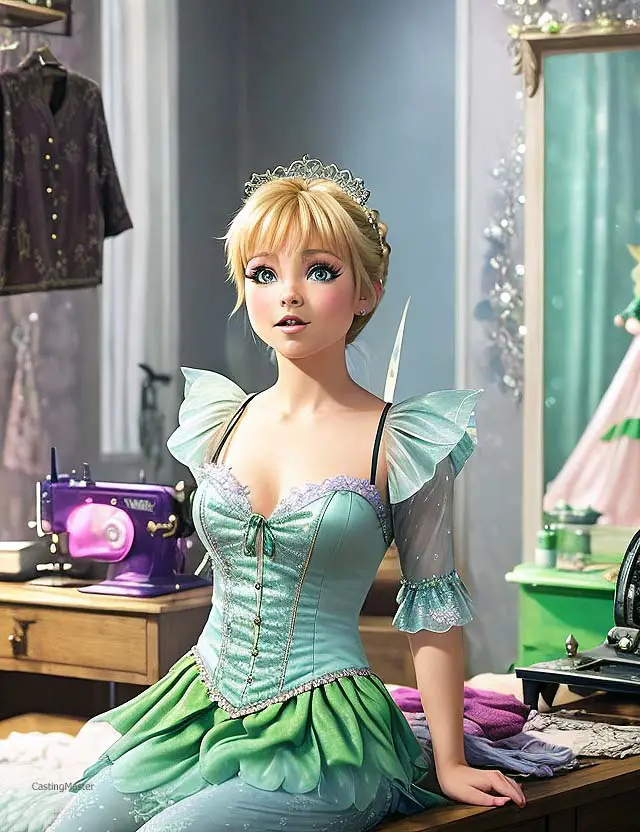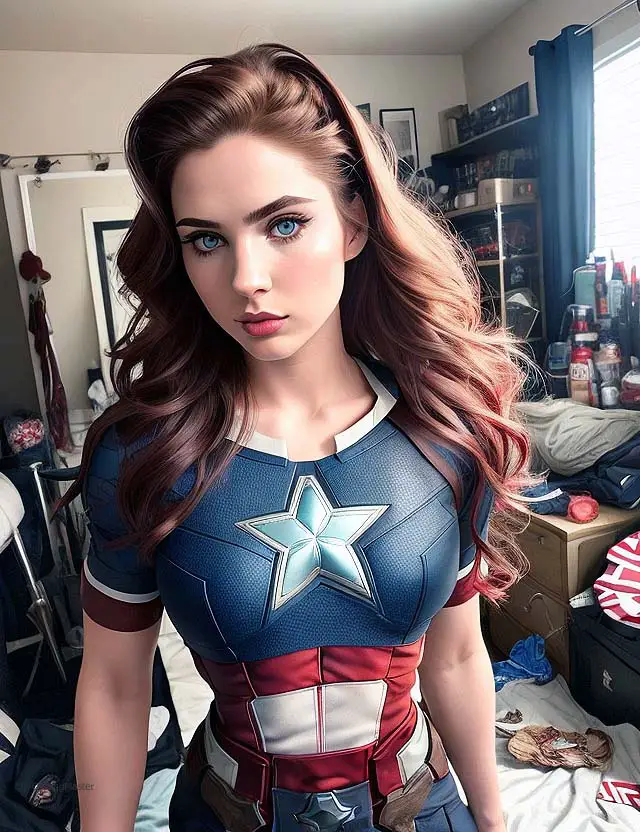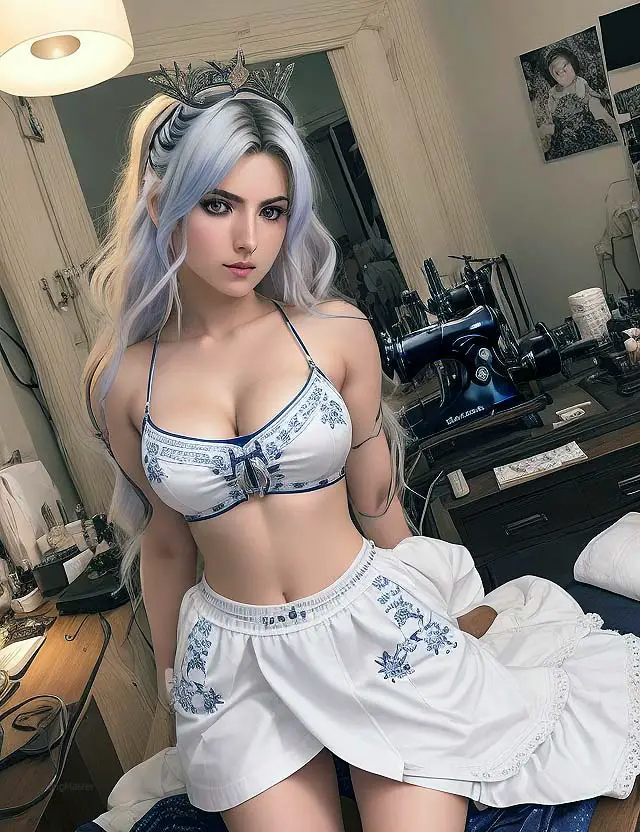Cosplay, short for costume play, is a popular hobby where people dress up as their favorite characters from movies, TV shows, video games and other forms of media. It’s not just about wearing a costume though; cosplayers often work hard to create an authentic and accurate portrayal of their character. This often involves a lot of intricate details and unique fabrics that you can’t simply buy at a store.
That’s why sewing is such an important skill for cosplay. When it comes to cosplay, the devil is in the details.
Every stitch counts when you’re trying to create your perfect representation of your favorite character. Whether it’s adding appliques or altering patterns to fit just right, sewing skills are essential in bringing a cosplay outfit to life.
There are two main methods of sewing that we’ll cover in this article: hand-sewing and using a sewing machine. Hand-sewing is ideal for small details or delicate fabrics while using a sewing machine can make larger projects much quicker and easier. If you’re looking to add extra details to your sewn project, we’ve created a full guide to crafting options.
Why Sewing Is Important For Cosplay
Sewing is an essential part of creating any cosplay outfit because it allows you to customize your costume to fit your body perfectly. It doesn’t matter if you’re making something entirely from scratch or altering an existing piece; the ability to sew opens up endless possibilities when it comes to creating the perfect cosplay outfit. Additionally, many cosplayers take pride in creating every aspect of their outfit themselves.
From the fabrics they choose to the embellishments they add, every detail is carefully crafted by hand (or machine). This level of dedication adds authenticity and uniqueness that sets their costumes apart from store-bought options.

The Two Methods Of Sewing Covered In This Article
In this article, we’ll cover two different methods of sewing: hand-sewing and using a sewing machine. Hand-sewing requires nothing more than a needle and thread, making it an accessible option for anyone who wants to start sewing for cosplay.
This method is ideal for adding decorative details or securing seams in delicate fabrics. Using a sewing machine is the more efficient way of sewing for cosplay, especially when it comes to larger projects like dresses or jackets.
A good quality sewing machine can make quicker work of even the most complicated patterns while ensuring that each stitch is even and secure. In the following sections, we’ll explore both methods in detail so you can decide which one is right for your project.
We’ll also cover how to choose fabric based on your character, as well as advanced techniques like embellishments and alterations. Whether you’re a beginner or an experienced seamstress, there’s something in this article for everyone looking to take their cosplay outfits to the next level!

Hand Sewing Basics
Tools and Materials Needed for Cosplay
When it comes to hand-sewing for cosplay, there are a few basic tools and materials that you will need. Firstly, you’ll need a good pair of fabric scissors to cut your fabric cleanly.
You’ll also want a measuring tape or ruler to measure out the dimensions of your pattern, as well as pins to hold the pieces in place while you sew. In addition to these essentials, you’ll also need needles, thread, and thimbles.
The type of needle and thread will depend on the fabric you’re using – thinner fabrics require finer needles and threads, while thicker fabrics require stronger ones. A thimble is useful if you’re sewing through thicker layers of fabric or if your fingers get sore from pushing the needle through.
It’s important to have a good light source so that you can see what you’re doing! A desk lamp with a bright bulb is ideal.
How to Sew Basic Stitches by Hand
Once you have all your tools and materials ready, it’s time to start sewing! There are several basic stitches that every cosplayer should know how to do. The most common stitch used in cosplay is the running stitch – this is used for most seams and hems.
To do a running stitch, bring the needle up through the fabric at one end of your seam, then push it back down through the other end. Continue this motion until your seam is complete.
Another useful stitch is the backstitch – this creates a stronger seam than the running stitch. To do a backstitch, bring your needle up through the fabric at one end of your seam as before.
Then take another stitch backwards (towards where you started), bringing your needle down into the same hole where it came up before. Continue alternating between forward and backward stitches to complete your seam.
If you need to sew two pieces of fabric together at an angle, you’ll want to use a whipstitch. This stitch is also useful for attaching trims or bias tape.
To do a whipstitch, bring your needle up through one layer of fabric, then over the edge to the other layer. Push the needle down through both layers of fabric close to the edge, then repeat this motion until your seam is complete.

Tips for Making Hand-Sewn Cosplay Items Look Professional
Hand-sewing can often look more amateurish than machine sewing, but there are several things you can do to make your hand-sewn cosplay items look more professional. Firstly, strive for consistency in your stitches – try to keep them evenly spaced and sized throughout the project. You can achieve this by practicing on scrap fabric first.
Another way to make your hand-sewn items look more polished is by pressing them with an iron. This will flatten out any wrinkles or bumps and give your seams a crisp finish.
Consider using decorative stitches – such as embroidery or cross-stitching – as accents on your cosplay items. These add an extra level of detail and help disguise any minor imperfections in your sewing!
Sewing Machine Basics
Overview of Different Types of Sewing Machines and Their Uses
Sewing machines come in many different types, each with its own unique set of features and uses. The most common type of sewing machine is the mechanical sewing machine, which is operated by a foot pedal and has a range of basic stitches. Computerized sewing machines are more advanced machines that can be programmed to automatically stitch complex patterns.
They also have a wider range of stitches and features than mechanical machines. Another type of sewing machine is the serger or overlock machine.
A serger is used to create neat, finished edges on fabric by trimming excess fabric as it sews. This type of machine is particularly useful for creating cosplay costumes that require clean edges.
Explanation of Basic Sewing Machine Tools and Materials Needed for Cosplay
Before getting started with using a sewing machine for cosplay, it’s important to have all the necessary tools and materials at hand. The most important tool you’ll need is a good quality sewing machine. You’ll also need a range of needles suitable for different fabrics, thread in various colours, scissors, pins, and a seam ripper.
When it comes to materials, you’ll want to choose high-quality fabrics that are appropriate for your cosplay project. You may also need interfacing (a material used to add structure or stability to fabric), zippers, buttons, elastic bands or other trims depending on your specific costume design.

Step-by-Step Instructions on How to Use a Sewing Machine for Basic Stitching
Using a sewing machine can seem daunting at first but with some practice and patience anyone can master it! Here’s how you can get started: Firstly ensure that your sewing machine needle is compatible with the fabric you’re using; thicker fabrics will require thicker needles.
Load up your sewing machine with the desired thread colour and follow the threading instructions in your machine manual. Set your stitch length and width according to your project needs.
A shorter stitch length is useful for securing seams while a longer stitch length is useful for basting. Use the handwheel to move the needle down into the fabric, then lower the presser foot lever.
Hold onto both thread tails and start sewing while keeping an even pressure on the fabric as you guide it through the machine. With some practice, you can use your sewing machine to create straight stitches, zigzag stitches and other decorative stitches depending on your cosplay costume design.
Learning how to use a sewing machine is an important skill for any cosplayer who wants to create high-quality costumes. By understanding different types of machines, basic tools and materials and step-by-step instructions on how to use a sewing machine for basic stitching, you’ll be well on your way to creating stunning cosplay costumes that will turn heads at any convention!
Choosing Fabric for Cosplay
Explanation of different types of fabrics used in cosplay
When it comes to cosplay, choosing the right fabric is essential to nailing your character’s look. There are a variety of fabrics used in cosplay, from cotton and polyester blends to more specialized options like spandex and faux leather. If you’d like to learn more checkout our deailed article on picking the perfect fabric for your cosplay.
Cotton and polyester blends are great for beginners because they’re easy to find and work with. They come in a wide range of colors and prints, making it easy to match with your character’s outfit.
Spandex is a popular choice for superheroes because it’s stretchy and form-fitting. It’s also great for tight-fitting bodysuits or leggings.
Faux leather is often used for armor or outerwear pieces such as jackets or vests. It gives off a stylish look that can be perfect if you want some shine in your costume.
Tips on how to choose the right fabric for a specific cosplay character
Choosing the right fabric can make or break your cosplay outfit. When deciding on what type of fabric to use, take into account not only the look you’re going for but also the character’s personality and role within their respective universe.
For example, if you’re cosplaying as a warrior-type character, you’ll likely need fabric that holds up well under wear and tear while still looking rugged. Fabrics like twill or denim could be good options here.
On the other hand, if you’re cosplaying as a princess-type character, you may want something more delicate with some sheen such as satin or silk. Another tip is to consider where your costume will be worn–indoors versus outdoors–and adjust accordingly based on factors such as weather conditions or lighting.

Discussion on fabric care and maintenance
Proper care and maintenance ensure that your cosplay outfit lasts long after the convention is over. Different fabrics require different care, so it’s important to read the labels and research the best ways to care for specific types of fabrics.
For example, delicate fabrics like silk may require handwashing or dry cleaning, while other more rugged options like denim can be machine washed and dried. Another tip is to store your cosplay outfit properly by hanging it up or folding it neatly to avoid wrinkles or damage.
Choosing the right fabric for your cosplay outfit is key to nailing your character’s look while fabric care and maintenance will ensure that your costume lasts beyond just one event. Take the time to research and invest in quality materials so you can truly bring your character to life.
Advanced Techniques: Embellishments, Alterations, and Repairs
Adding Embellishments for that Extra Flair
Adding embellishments to your cosplay costume can take it from average to exceptional. There is a wide range of embellishments that you can add to your costume, depending on the character you are portraying.
You can add sequins, beads, lace trims, embroidery designs, and appliques. To add these embellishments by hand-sewing requires patience and skill.
You will need to have a steady hand and be comfortable with using small needles. Alternatively, you may use a sewing machine with specialized presser feet for different types of embellishment work.
When adding sequins or beads by hand-sewing, using a line of invisible thread makes it look like the beads are floating on the fabric. You can also use thread in a color that matches the fabric for smaller embellishment jobs where the thread won’t be seen.
Altering Patterns: Making it Work for Your Body Type
Sometimes store-bought patterns do not fit perfectly or may not be readily available in your size range. In such cases, altering patterns becomes necessary. Altering patterns by hand or sewing machine takes practice and knowledge of basic pattern-making techniques.
The first step in pattern alteration is taking accurate body measurements. This information is critical in adjusting the length or width of pattern pieces to fit your body type properly.
There are various pattern-altering techniques including slashing and pivoting methods used when altering sleeves or darts on dresses. When making more significant alterations such as adjusting trouser legs’ width or shortening jacket sleeves length, use a sewing machine instead of hand-sewing because it gives better results.
Repairing Damaged Costumes: Give them Another Chance
Cosplay costumes get lots of wear and tear during conventions or photoshoots. It’s not unheard of for costumes to suffer damage and need repairs. Instead of throwing away a costume, repairing it can give it a new lease of life.
Hand-sewing is an ideal option for repairing minor rips or small holes. However, if the damage is significant, using a sewing machine with the appropriate needle and thread can be more effective.
When repairing cosplay costumes, use matching thread to achieve a seam that blends in well with the fabric. Upholstery thread works well when sewing heavier fabrics like leather or vinyl.
Embellishing your cosplay with different types of trims, beads, sequins or embroidery designs can make your costume stand out from the rest. Alternatively, altering patterns to fit your body type ensures that your cosplay costume fits you perfectly and looks as close as possible to the character you are portraying. Never give up on damaged costumes!
With some basic sewing skills and knowledge on how to operate a sewing machine correctly; you’ll be able to bring life back into them again. Mastering advanced techniques like resin casting, foam props or electronics, and repairs can take time and practice but add an extra level of detail that makes your finished cosplay look more professional.
Conclusion: Putting It All Together
Recap of Key Points Covered in the Article
Throughout this article, we’ve covered the basics of sewing for cosplay, both by hand and with a sewing machine. We began by discussing what cosplay is and why sewing is important for creating authentic-looking costumes.
Then, we delved into the basics of hand-sewing, covering tools and materials needed as well as step-by-step instructions on basic stitches. Next, we moved onto using a sewing machine, discussing different types of machines and their uses along with basic tools and materials needed.
We then discussed choosing fabric for cosplay costumes along with tips on how to choose the right fabric for a specific character and how to care for it once you’ve finished your costume. We covered advanced techniques such as adding embellishments, altering patterns, and repairing damaged costumes.
Final Tips On…
As you start your journey into cosplay sewing, here are some final tips to keep in mind:
1. Practice makes perfect: Don’t get discouraged if your first project doesn’t turn out exactly how you wanted it to. Keep practicing your skills and eventually you’ll get better.
2. Take breaks: Sewing can be tiring work that requires precision and focus. Don’t forget to take breaks to stretch or rest your eyes.
3. Be patient: Sewing takes time – especially if you’re creating something intricate or using a new technique for the first time.
4. Have fun: Remember that at the heart of it all, cosplay is about having fun!
Don’t let perfectionism get in the way of enjoying the process. With these tips in mind along with everything else covered in this article – from basic stitching techniques to advanced alterations – you’re well on your way to creating amazing costumes that will help bring your favorite characters to life!





